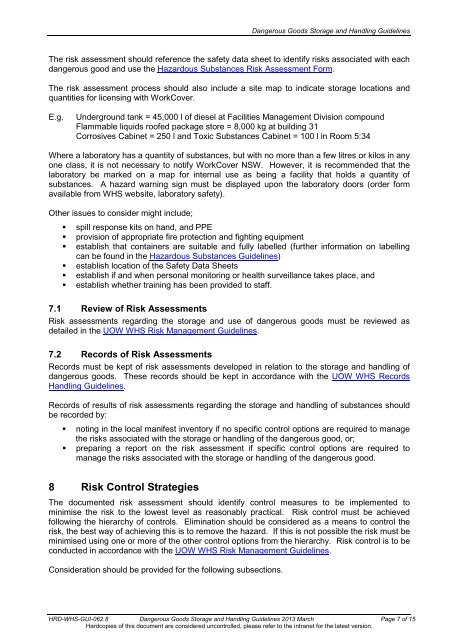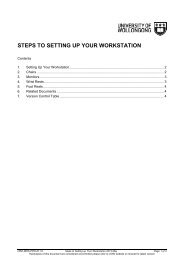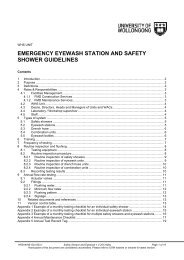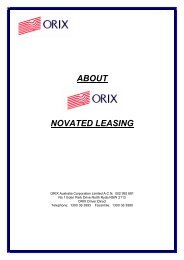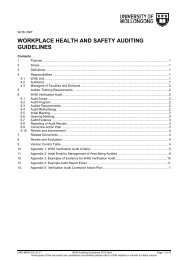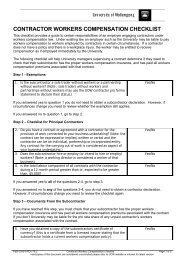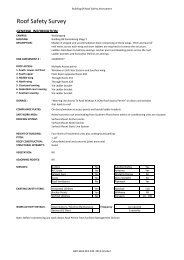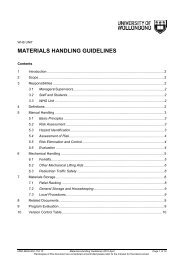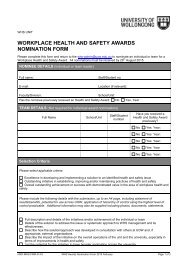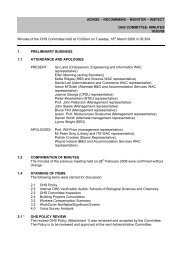Dangerous Goods Storage and Handling Guidelines - Staff
Dangerous Goods Storage and Handling Guidelines - Staff
Dangerous Goods Storage and Handling Guidelines - Staff
You also want an ePaper? Increase the reach of your titles
YUMPU automatically turns print PDFs into web optimized ePapers that Google loves.
<strong>Dangerous</strong> <strong>Goods</strong> <strong>Storage</strong> <strong>and</strong> H<strong>and</strong>ling <strong>Guidelines</strong><br />
The risk assessment should reference the safety data sheet to identify risks associated with each<br />
dangerous good <strong>and</strong> use the Hazardous Substances Risk Assessment Form.<br />
The risk assessment process should also include a site map to indicate storage locations <strong>and</strong><br />
quantities for licensing with WorkCover.<br />
E.g.<br />
Underground tank = 45,000 l of diesel at Facilities Management Division compound<br />
Flammable liquids roofed package store = 8,000 kg at building 31<br />
Corrosives Cabinet = 250 l <strong>and</strong> Toxic Substances Cabinet = 100 l in Room 5:34<br />
Where a laboratory has a quantity of substances, but with no more than a few litres or kilos in any<br />
one class, it is not necessary to notify WorkCover NSW. However, it is recommended that the<br />
laboratory be marked on a map for internal use as being a facility that holds a quantity of<br />
substances. A hazard warning sign must be displayed upon the laboratory doors (order form<br />
available from WHS website, laboratory safety).<br />
Other issues to consider might include;<br />
• spill response kits on h<strong>and</strong>, <strong>and</strong> PPE<br />
• provision of appropriate fire protection <strong>and</strong> fighting equipment<br />
• establish that containers are suitable <strong>and</strong> fully labelled (further information on labelling<br />
can be found in the Hazardous Substances <strong>Guidelines</strong>)<br />
• establish location of the Safety Data Sheets<br />
• establish if <strong>and</strong> when personal monitoring or health surveillance takes place, <strong>and</strong><br />
• establish whether training has been provided to staff.<br />
7.1 Review of Risk Assessments<br />
Risk assessments regarding the storage <strong>and</strong> use of dangerous goods must be reviewed as<br />
detailed in the UOW WHS Risk Management <strong>Guidelines</strong>.<br />
7.2 Records of Risk Assessments<br />
Records must be kept of risk assessments developed in relation to the storage <strong>and</strong> h<strong>and</strong>ling of<br />
dangerous goods. These records should be kept in accordance with the UOW WHS Records<br />
H<strong>and</strong>ling <strong>Guidelines</strong>.<br />
Records of results of risk assessments regarding the storage <strong>and</strong> h<strong>and</strong>ling of substances should<br />
be recorded by:<br />
• noting in the local manifest inventory if no specific control options are required to manage<br />
the risks associated with the storage or h<strong>and</strong>ling of the dangerous good, or;<br />
• preparing a report on the risk assessment if specific control options are required to<br />
manage the risks associated with the storage or h<strong>and</strong>ling of the dangerous good.<br />
8 Risk Control Strategies<br />
The documented risk assessment should identify control measures to be implemented to<br />
minimise the risk to the lowest level as reasonably practical. Risk control must be achieved<br />
following the hierarchy of controls. Elimination should be considered as a means to control the<br />
risk, the best way of achieving this is to remove the hazard. If this is not possible the risk must be<br />
minimised using one or more of the other control options from the hierarchy. Risk control is to be<br />
conducted in accordance with the UOW WHS Risk Management <strong>Guidelines</strong>.<br />
Consideration should be provided for the following subsections.<br />
HRD-WHS-GUI-062.8 <strong>Dangerous</strong> <strong>Goods</strong> <strong>Storage</strong> <strong>and</strong> H<strong>and</strong>ling <strong>Guidelines</strong> 2013 March Page 7 of 15<br />
Hardcopies of this document are considered uncontrolled, please refer to the intranet for the latest version.


